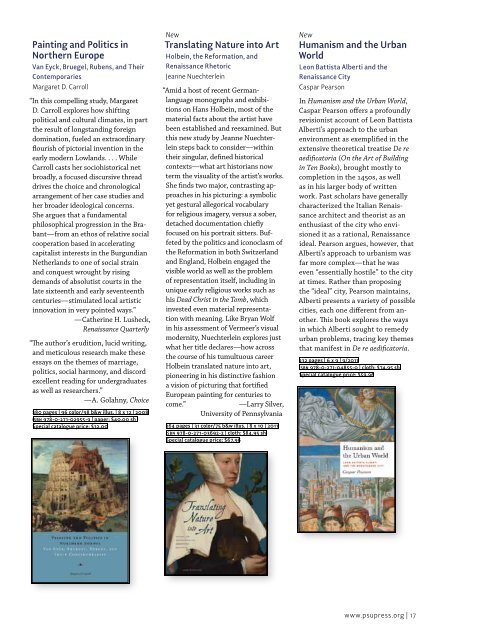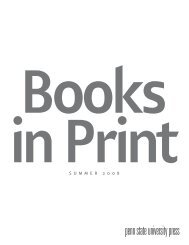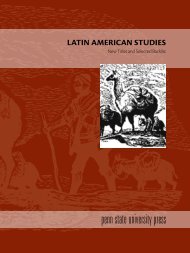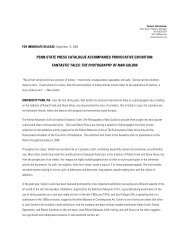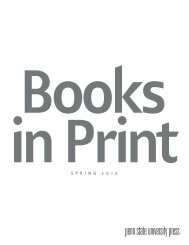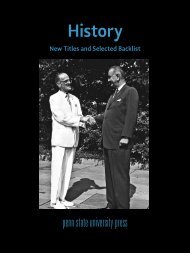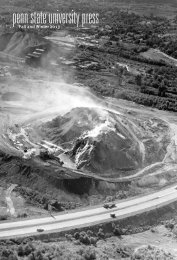Download the Catalog (PDF) - Pennsylvania State University Press
Download the Catalog (PDF) - Pennsylvania State University Press
Download the Catalog (PDF) - Pennsylvania State University Press
Create successful ePaper yourself
Turn your PDF publications into a flip-book with our unique Google optimized e-Paper software.
Painting and Politics in<br />
Nor<strong>the</strong>rn Europe<br />
Van Eyck, Bruegel, Rubens, and Their<br />
Contemporaries<br />
Margaret D. Carroll<br />
“In this compelling study, Margaret<br />
D. Carroll explores how shifting<br />
political and cultural climates, in part<br />
<strong>the</strong> result of longstanding foreign<br />
domination, fueled an extraordinary<br />
flourish of pictorial invention in <strong>the</strong><br />
early modern Lowlands. . . . While<br />
Carroll casts her sociohistorical net<br />
broadly, a focused discursive thread<br />
drives <strong>the</strong> choice and chronological<br />
arrangement of her case studies and<br />
her broader ideological concerns.<br />
She argues that a fundamental<br />
philosophical progression in <strong>the</strong> Brabant—from<br />
an ethos of relative social<br />
cooperation based in accelerating<br />
capitalist interests in <strong>the</strong> Burgundian<br />
Ne<strong>the</strong>rlands to one of social strain<br />
and conquest wrought by rising<br />
demands of absolutist courts in <strong>the</strong><br />
late sixteenth and early seventeenth<br />
centuries—stimulated local artistic<br />
innovation in very pointed ways.”<br />
<br />
—Ca<strong>the</strong>rine H. Lusheck,<br />
<br />
Renaissance Quarterly<br />
“The author’s erudition, lucid writing,<br />
and meticulous research make <strong>the</strong>se<br />
essays on <strong>the</strong> <strong>the</strong>mes of marriage,<br />
politics, social harmony, and discord<br />
excellent reading for undergraduates<br />
as well as researchers.”<br />
<br />
—A. Golahny, Choice<br />
280 pages | 96 color/98 b&w illus. | 8 x 12 | 2008<br />
isbn 978-0-271-02955-9 | paper: $40.00 sh<br />
Special catalogue price: $32.00<br />
New<br />
Translating Nature into Art<br />
Holbein, <strong>the</strong> Reformation, and<br />
Renaissance Rhetoric<br />
Jeanne Nuechterlein<br />
“Amid a host of recent Germanlanguage<br />
monographs and exhibitions<br />
on Hans Holbein, most of <strong>the</strong><br />
material facts about <strong>the</strong> artist have<br />
been established and reexamined. But<br />
this new study by Jeanne Nuechterlein<br />
steps back to consider—within<br />
<strong>the</strong>ir singular, defined historical<br />
contexts—what art historians now<br />
term <strong>the</strong> visuality of <strong>the</strong> artist’s works.<br />
She finds two major, contrasting approaches<br />
in his picturing: a symbolic<br />
yet gestural allegorical vocabulary<br />
for religious imagery, versus a sober,<br />
detached documentation chiefly<br />
focused on his portrait sitters. Buffeted<br />
by <strong>the</strong> politics and iconoclasm of<br />
<strong>the</strong> Reformation in both Switzerland<br />
and England, Holbein engaged <strong>the</strong><br />
visible world as well as <strong>the</strong> problem<br />
of representation itself, including in<br />
unique early religious works such as<br />
his Dead Christ in <strong>the</strong> Tomb, which<br />
invested even material representation<br />
with meaning. Like Bryan Wolf<br />
in his assessment of Vermeer’s visual<br />
modernity, Nuechterlein explores just<br />
what her title declares—how across<br />
<strong>the</strong> course of his tumultuous career<br />
Holbein translated nature into art,<br />
pioneering in his distinctive fashion<br />
a vision of picturing that fortified<br />
European painting for centuries to<br />
come.” <br />
—Larry Silver,<br />
<strong>University</strong> of <strong>Pennsylvania</strong><br />
264 pages | 31 color/75 b&w illus. | 8 x 10 | 2011<br />
isbn 978-0-271-03692-2 | cloth: $84.95 sh<br />
Special catalogue price: $67.96<br />
New<br />
Humanism and <strong>the</strong> Urban<br />
World<br />
Leon Battista Alberti and <strong>the</strong><br />
Renaissance City<br />
Caspar Pearson<br />
In Humanism and <strong>the</strong> Urban World,<br />
Caspar Pearson offers a profoundly<br />
revisionist account of Leon Battista<br />
Alberti’s approach to <strong>the</strong> urban<br />
environment as exemplified in <strong>the</strong><br />
extensive <strong>the</strong>oretical treatise De re<br />
aedificatoria (On <strong>the</strong> Art of Building<br />
in Ten Books), brought mostly to<br />
completion in <strong>the</strong> 1450s, as well<br />
as in his larger body of written<br />
work. Past scholars have generally<br />
characterized <strong>the</strong> Italian Renaissance<br />
architect and <strong>the</strong>orist as an<br />
enthusiast of <strong>the</strong> city who envisioned<br />
it as a rational, Renaissance<br />
ideal. Pearson argues, however, that<br />
Alberti’s approach to urbanism was<br />
far more complex—that he was<br />
even “essentially hostile” to <strong>the</strong> city<br />
at times. Ra<strong>the</strong>r than proposing<br />
<strong>the</strong> “ideal” city, Pearson maintains,<br />
Alberti presents a variety of possible<br />
cities, each one different from ano<strong>the</strong>r.<br />
This book explores <strong>the</strong> ways<br />
in which Alberti sought to remedy<br />
urban problems, tracing key <strong>the</strong>mes<br />
that manifest in De re aedificatoria.<br />
232 pages | 6 x 9 | 9/2011<br />
isbn 978-0-271-04855-0 | cloth: $74.95 sh<br />
Special catalogue price: $59.96<br />
www.psupress.org | 17


